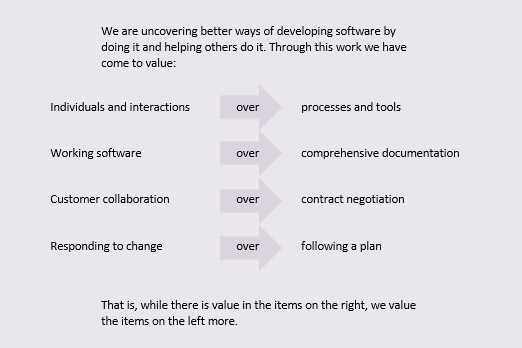The ‘Manifesto for Agile Software Development’ was originally developed in February 2001 at a meeting in Utah, USA. Later that year it was published as the ‘Agile Manifesto’ and many of the original 17 authors went on to create the Agile Alliance.
The manifesto itself is shown below. It is a brief statement that describes four values that relate to “better ways of developing software”. These are described in four contrasting pairs. While the authors recognise the value of the items on the right, they value those on the left more.
As is often pointed out, the manifesto does not suggest that the items on the right are unnecessary. It simply says that those on the left have greater value.

The values were underpinned by 12 principles that brought together many existing good practices, blended them with new ideas and placed all these in a very specific software development environment.
-
Our highest priority is to satisfy the customer through early and continuous delivery of valuable software.
-
Welcome changing requirements, even late in development. Agile processes harness change for the customer's competitive advantage.
-
Deliver working software frequently, from a couple of weeks to a couple of months, with a preference to the shorter timescale.
-
Business people and developers must work together daily throughout the project.
-
Build projects around motivated individuals. Give them the environment and support they need, and trust them to get the job done.
-
The most efficient and effective method of conveying information to and within a development team is face-to-face conversation.
-
Working software is the primary measure of progress.
-
Agile processes promote sustainable development. The sponsors, developers, and users should be able to maintain a constant pace indefinitely.
-
Continuous attention to technical excellence and good design enhances agility.
-
Simplicity - the art of maximizing the amount of work not done - is essential.
-
The best architectures, requirements, and designs emerge from self-organizing teams.
-
At regular intervals, the team reflects on how to become more effective, then tunes and adjusts its behaviour accordingly.
The original Agile Manifesto has spawned an entire movement referred to simply as ‘Agile’ which enthusiasts apply to just about any aspect of human endeavour, whether it be HR, marketing or project and programme management.
Unfortunately, this has led to the perception that ‘Agile Project and Programme Management’ are fundamentally different to all other forms of project and programme management, which is not the case.
Agility has always been part of project and programme management to some degree as illustrated in approaches such as Concurrent Engineering and models such as the WHOW matrix.
This is increasingly being recognised in the discussion of 'hybrid' approaches that blend serial and parallel life cycles to create a tailored approach to the context of each individual project or programme.





